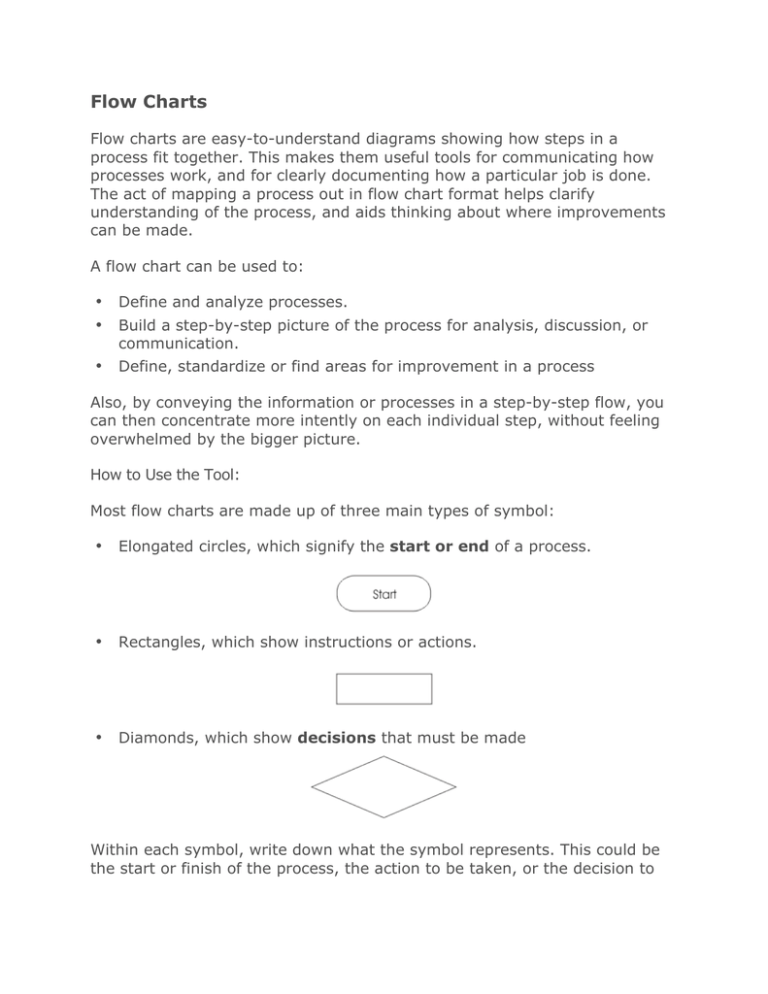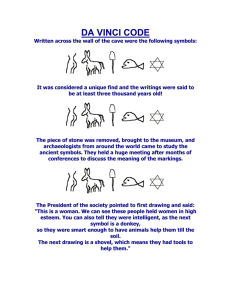Flow Charts
advertisement

Flow Charts Flow charts are easy-to-understand diagrams showing how steps in a process fit together. This makes them useful tools for communicating how processes work, and for clearly documenting how a particular job is done. The act of mapping a process out in flow chart format helps clarify understanding of the process, and aids thinking about where improvements can be made. A flow chart can be used to: • Define and analyze processes. • Build a step-by-step picture of the process for analysis, discussion, or communication. • Define, standardize or find areas for improvement in a process Also, by conveying the information or processes in a step-by-step flow, you can then concentrate more intently on each individual step, without feeling overwhelmed by the bigger picture. How to Use the Tool: Most flow charts are made up of three main types of symbol: • Elongated circles, which signify the start or end of a process. • Rectangles, which show instructions or actions. • Diamonds, which show decisions that must be made Within each symbol, write down what the symbol represents. This could be the start or finish of the process, the action to be taken, or the decision to be made. Symbols are connected one to the other by arrows, showing the flow of the process. There are many other flowchart symbols that can also be used. However, remember that an important use of flow charts is in communication: If you use obscure symbols that only part of your audience understands, there's a good chance that your communication will fail. Keep things simple! Drawing a Flow Chart To draw the flow chart, brainstorm process tasks, and list them in the order they occur. Ask questions such as "What really happens next in the process?" and "Does a decision need to be made before the next step?" or "What approvals are required before moving on to the next task?" Start the flow chart by drawing the elongated circle shape, and labeling it "Start". Then move to the first action or question, and draw a rectangle or diamond appropriately. Write the action or question down, and draw an arrow from the start symbol to this shape. Work through your whole process, showing actions and decisions appropriately in the order they occur, and linking these together using arrows to show the flow of the process. Where a decision needs to be made, draw arrows leaving the decision diamond for each possible outcome, and label them with the outcome. And remember to show the end of the process using an elongated circle labeled "Finish". Finally, challenge your flow chart. Work from step to step asking yourself if you have correctly represented the sequence of actions and decisions involved in the process. And then (if you're looking to improve the process) look at the steps identified and think about whether work is duplicated, whether other steps should be involved, and whether the right people are doing the right jobs. Example: The example below shows part of a simple flow chart which helps a receptionist route incoming phone calls to the correct department in a company: Key Points: Flow charts are simple diagrams that map out a process so that it can easily be communicated to other people. To draw a flowchart, brainstorm the tasks and decisions made during a process, and write them down in order. Then map these out in flow chart format using appropriate symbols for the start and end of a process, for actions to be taken and for decisions to be made. Finally, challenge your flow chart to make sure that it's an accurate representation of the process, and that that it represents the most efficient way of doing the job.


